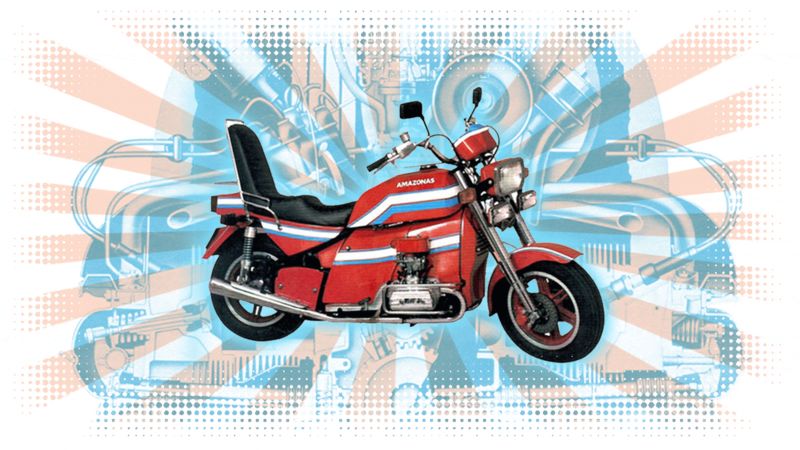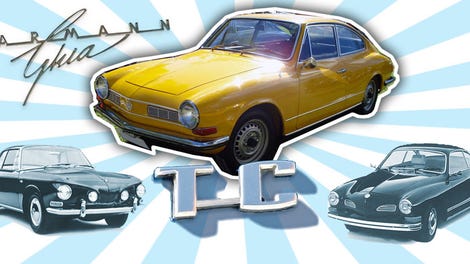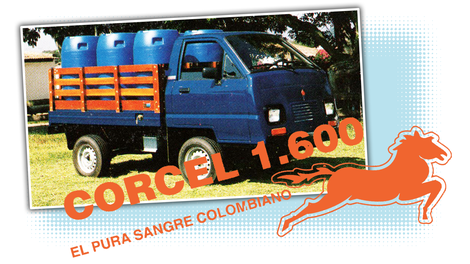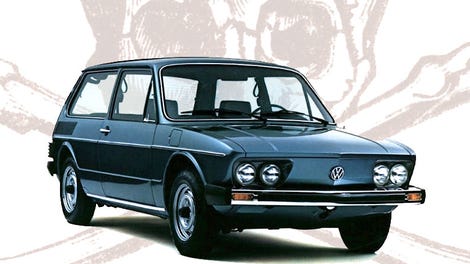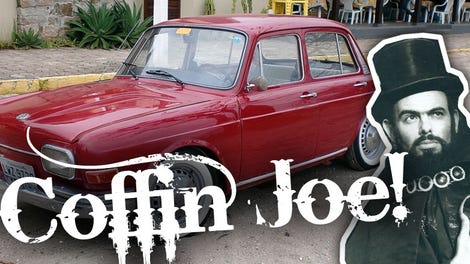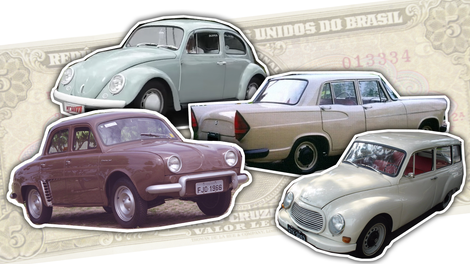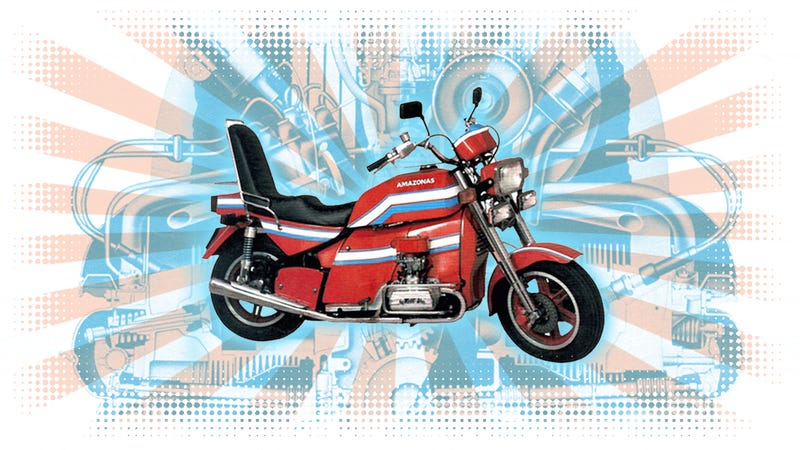
Brazil in the 1970s to early 1990s was a fascinating crucible for the creation of weird vehicles. Their protectionist trade policies forced local solutions to everything, and the results were oftenfascinating. I’ve covered, at length, the strangeVolkswagenvariationsthatbloomedthere, and now I’d like to cover one more, one with half as many wheels as what I usually obsess over.
Yes, this time the weird Brazilian air-cooled Volkswagen mutant I’m talking about isn’t a car at all: it’s a motorcycle. A massive, 900 pound, hulking crude mass of a motorcycle with a VW flat-four air-cooled engine and transaxle at its loud, clattery heart. It’s called the the AME Amazonas 1600.
Advertisement
The Amazonas was born in the late 1970s when two friends in São Paulo, Luiz Antonio Gomi and José Carlos Biston, decided that what Brazil needed was a motorcycle with a VW engine. I’ve heard two main reasons why they came to this conclusion, one simple, one more complex.
Advertisement
The simple idea is best summed up in a statement attributed to Gomi:
“…I had a Harley and a Beetle. Every time I got out of Harley, there were always small problems: You know how to break a chain, unload the battery, and so on…and whenever I went to the rescue, it was my [exhausting]. I THOUGHT, I’LL PLACE THE VW ENGINE ON [the] HARLEY…It never breaks!!!”
So, basically, the Amazonas was born because someone was sick of their Harley breaking down, and wanted the kind of reliability they had with their Fusca (that’s what the Brazilians call the Beetle).
Advertisement
Now, that explanation may seem a little too simplistic, and I think it is. The more involved reason is laid out in a wonderful article on the site Odd Bike, which also attributes the origin of the Amazonas to a different inventor, Daniel Rodriguez.
In this telling, Brazil’s protectionist trade policies had left the country without any larger, powerful motorcycles on the market, and the Brazilian police forces had been nurturing a fleet of aging Harley-Davidsons that were only still going because there really wasn’t any good locally-built replacement.
Advertisement
That’s where Rodriguez comes in:
Sao Paolo based tinkerer Daniel Rodriguez saw the gap and decided he would design and build a motorcycle to suit the needs of the police force. It would have to be rugged, reliable, easy to maintain, and built with existing parts – parts that were produced in Brazil to avoid the problem of import duties. As Volkswagen had been manufacturing the Beetle in Brazil since the 1950s, it made sense to use VW parts… In Rodriguez’s mind, anyway. He set about building a hulking touring machine around the cockroach-tough air-cooled 1600cc Type 1 VW motor and transmission, and in 1977 the mighty Amazonas was unleashed upon an unsuspecting world.
Really, it’s a pretty clever idea: if there’s no decent large motorcycles to replace those Harleys, build something with what you have plenty of: air-cooled VW flat-fours. Luckily, the very design of an air-cooled opposed engine lends itself well to motorcycle design, so this was at least possible.
The two origin stories seem to be both accurate, as a Brazilian site describes the history in a way that merges the two stories. The original VW-powered bike does seem to have been built by Biston and Gomi, a one-off they called the Motovolks.
Advertisement
Advertisement
This proto-Amazonas was a Frankensteinean beast made with pieces of a ‘50s Indian motorcycle frame and pieces of Harley-Davidson frames. They jammed in a 1500cc VW engine, added a bigger oil cooler and twin carbs, and a Simca instrument cluster that didn’t work, but looked cool.
A few more Motovolks were built, when Rodriguez, a businessman who owned an auto parts company, encountered the bike and decided to put it into production, likely because he was aware of the motorcycle needs of the Brazilian police, and anticipated that, with Brazil’s ever-improving road network and economic growth, there would be a growing market for a large touring motorcycle.
The Amazonas 1500 (later 1600) that came out of this was an absolute beast: at the time, it was called the largest motorcycle in the world (at least based on displacement, though probably overall as well), and was likely the first (and possibly only) motorcycle with an actual reverse gear.
Advertisement
Advertisement
Now, large bikes like a Honda Goldwing can reverse, but they use an idler gear and the starter motor to do so; the Amazonas, using a normal VW four-speed transmission (from the Brasilia) actually used the regular reverse gear.
In fact, the way the VW transaxle was adapted to function in the Amazonas gives a good sense of how the bike was designed overall. There wasn’t a special, custom final drive made for the one driven wheel; rather, the differential gears were just welded together and a drive chain sprocket was mounted to one of the rear half-shafts (shortened, the other side removed), and a massive chain used to drive the rear wheel.
It was crude, but it worked, and that seemed to be the basic character of the motorcycle itself. Almost every review or report about the bike makes clear how brutal, heavy, and basic it was, but the things just didn’t seem to break, which is why the Brazilian motorcycle cops kept using them all throughout the 1980s.
Also interesting and very Brazilian was the fact that in 1978 there was an alcool variant, to run on the local Brazilian sugar-cane-alcohol fuel, like some VW Fuscas did.
Advertisement
Advertisement
The design of the bike got a lot of criticism because it seemed to be even more bulky and unrefined than it needed to be. For example, it’s often pointed out that the VW engine itself could have been used as a stressed member and saved a lot of weight from the frame of the bike, but that opportunity was not taken.
Foreign reviews of the era tend to be a bit brutal. This is from a 1987 issue of Dream Bikes magazine. I’m including three full paragraphs here, because they’re so effective at conveying distaste and disdain:
The outdated Russian Dniepr/ Ural flat twins used to be the means by which we reminded ourselves of the excellence of most latter-day Japanese and European motorcycles, but now the Amazonas has amply – and that’s the motjuste for a two-wheeler scaling 386 kg dry and with a wheelbase of no less than 1680 mm – usurped the Eastern Bloc bikes in this educational role. The Brazilian Behemoth, built in Sao Paulo and powered by the air-cooled flat-four horizontally opposed pushrod Volkswagen engine, is so lacking in sophistication and finish that you can scarcely credit that someone, somewhere is actually building them in series production, still less finding buyers for the end result.
Curiously, instead of using the VW engine’s inherent strength to advantage by making it a fully stressed member, Ferreira has constructed a crudely welded full duplex chassis, into which the unit isshoehorned, thus adding weight and reducing rigidity. The overall design concept of the Amazonas is basically amateur, as are the details: look at those evil castings for the footboards, or the brake master cylinder, carelessly sculpted by hand complete with many shaky lines where the artisan paused for a slug from the sugar-cane still. Or look at the massive front forks, no less than 48 mm in diameter with barely noticeable damping, and fitted with weighty 10 mm-thick cast-iron disc brakes, borrowed like the large ATE calipers from a local Ford car, and twice as thick and times as heavy as most normal bike brakes.
However, the conversion from hand to foot change is crude and unwieldy, although the single-conversion to chain final drive, which is cheaper than making their own hypoid rear unit for bike use, results in a very long chain run and inevitable snatch. Theoretical plate, cable-operated VW diaphragm clutch is light to use. There’s the VW crown wheel and pinion, but Amazonas’s own top speed is 100 mph (160 kph) with the twin-carb engine, but you’d have to be a brave man to push an Amazonas to those extremes… Apart from the clutch, all the controls are unbelievably heavy, directional stability is a problem at almost any speed, and the rock-hard rear suspension, itself a primitive layout combining totally ineffective locally made dampers with a primitive plunger-type rear-axle location that went out of style thirty years ago in Europe, gives a bone-crushing ride.
Still, likely because I’m an absolute moron, I can’t help but find the Amazonas appealing, maybe just because it is so legendarily awful. Even to my non-biker’s eyes, I can see that it’s strangely bulky in pretty much every dimension, but I can’t honestly say I don’t kind of like the way it looks.
Being so heavy, it wasn’t particularly quick with the stock 56 horsepower engine, but there’s so many ways to get more power from a Beetle motor many owners did manage to make harrowingly fast bikes.
Advertisement
Advertisement
The beast survived into the early 1990s, with a re-design that gave the bike a makeover that turned it from looking like an elephantine ‘70s cruiser into something that looked like a Honda Gold wing wearing a sportbike Halloween costume. This variant was called the 1600 Kahena, which made a face-flambé-ing 64 hp.
Personally, I’d rather think of the Amazonas not so much as a terrible, heavy, crude caricature of a motorcycle, and more as a remarkable demonstration device showcasing the amazing versatility of the Volkswagen air-cooled drivetrain.
Sure, it may have been a crappy motorcycle, but as far as VW Beetles with half their wheels missing go, it was fantastic.
Advertisement
(Many thanks to Eduardo!)
Just FYI, I cover the shit out of Brazilian VWs and other cars

